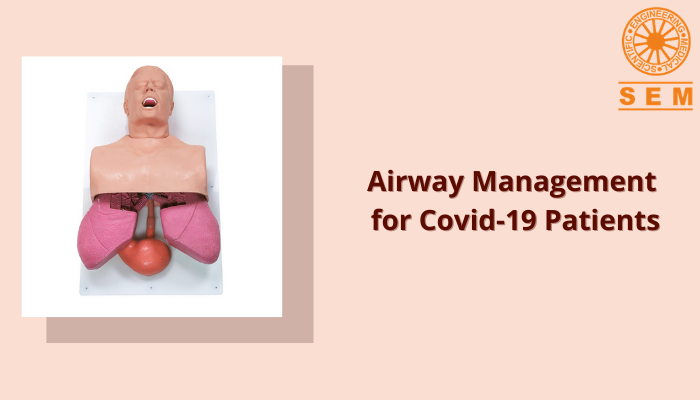Airway Management & Hospitalization for Covid-19 Patients
The sudden outbreak of novel coronavirus disease 2019 (COVID-19), brought frontline healthcare workers at high risk of getting contaminated and spreading the infection. Many healthcare professionals are being disproportionately affected by it and there are several hospital-related infections that are being widely reported. The healthcare workers who are treating severely ill patients of covid-19 are involved in airway management and thus, are at great risk because of the incubators.
To give an example of the same, the anaesthesiologists who are working in Wuhan, China, were affected with covid-19 in large proportion after treating the patients with endotracheal intubation. This is because intubation triggers aerosolization of minute particles that contain the virus with them and then, these minute particles, when suspended in the air, travel further distances if not aerosolized and get inhaled, increasing the risk of infection. This is the reason, intensivists, anesthesiologists, and other members in the airway management team, are required to be very careful during their performance of tracheal intubation for patients infected with covid-19.
As we can see here, those who are involved in the airway management of the patients of covid-19 are, particularly at high risk. So we are listing down a stepwise and practical protocol for secure airway management in hospitals with confirmed or suspected covid-19 infection.
Learn more: Adult Deluxe Airway Management Trainer
Need of Airway Management
As the count of patients that are infected with covid-19 has grown exponentially, the count of patients who are required to be treated with intubation is also greater because the non-invasive ventilation comes less in usage because of the greater risk of aerosolization of the viral particles. Speaking of which, there are rapid viral transmissions in hospitals that remain a major thing to worry about and are documented as well.
In Italy, there were 9% of healthcare workers who were intubating providers, respiratory therapists and bedside nurses being at complete risk. There were a large number of employees who have tested positive for covid-19 out of the total number of positive tested inpatients.
The continuously emerging data dictates an unprecedented and alarming need for being alert and prepared, as the healthcare workers will definitely be at risk of the exposure from being involved in airway management. So, it’s imperative that we have a stepwise protocol for safe airway management and hospitalization for the patients who are suspected or infected with covid-19.
In COVID-19 patients, airway management is often required due to the development of severe respiratory distress, which can lead to hypoxemia (low oxygen levels in the blood) and respiratory failure. These patients may require advanced airway management techniques, such as intubation or tracheostomy, to support their breathing and oxygenation. Intubation involves the insertion of a breathing tube into the patient’s airway, while tracheostomy involves the creation of an opening in the patient’s neck to access their airway.
Do Check: Advanced Infant Intubation with Board
Steps for Airway Management & Hospitalization of Covid-19 Patients
1. Avoid Emergent Intubations
All efforts should be made to avoid emergently intubating patients of covid-19, given the increased risk of exposure to healthcare providers. Hand hygiene is one crucial step that should be followed at first to protect someone from the viral spread.
Secondly, all the healthcare providers who are involved in airway management should have ample amount of time for the application of airborne precaution personal protective equipment (PPE) prior to beginning with the treatment. This airborne PPE kit for covid-19 includes a fit-tested respirator like an N95 mask, eye protection, a fluid-resistant gown and gloves for hand touch safety.
Double gloving might be considered while intubating, such as discarding one layer of gloves after securing the airway, before any other recruitment is being handled. Another protection may be used and worn if available, is a powered air-purifying respirator (PAPR) which provides high calibre safety.
Read more: AirSim Baby with Realistic Anatomy and Clinical Functionality
2. Respiratory Rounds
The airway response team (ART) considers treating patients with confirmed or suspected covid-19 infection for close evaluation of clinical trajectory. When the number of infected patients exceeds the number of patients that are to be accommodated in an ICU, this approach might result in being beneficial in such circumstances. A designated patient unit should be created for covid-19 patients in order to isolate them from other patients. Also, dissemination of information and centralized monitoring should be allowed that is specific to covid-19 care.
Don’t miss: Critical Airway Management Trainer
Other Necessary Protocols
- N95 masks are less safer than PAPR for respiratory PPE. But they are easily available and affordable and hence, can be used.
- Communication and consultation with the airway team should be done if there is evidence of respiratory distress or escalating oxygen requirements.
- Minimize high flow nasal cannula and non-invasive positive pressure ventilation.
- Post-intubation and extubation considerations for patients with covid-19.
- Designation of a covid-19 unit.
Learn more: Infant Airway Trainer with Stand
Conclusion
The most needed recommendation consists of close monitoring of respiratory status for cautious use of NIV and HFNC, early signs of failure, use of video laryngoscopy, minimizing coughing, consideration of early intubation, and viral aerosolization at the time of induction with medications like high dose rocuronium and lidocaine.

